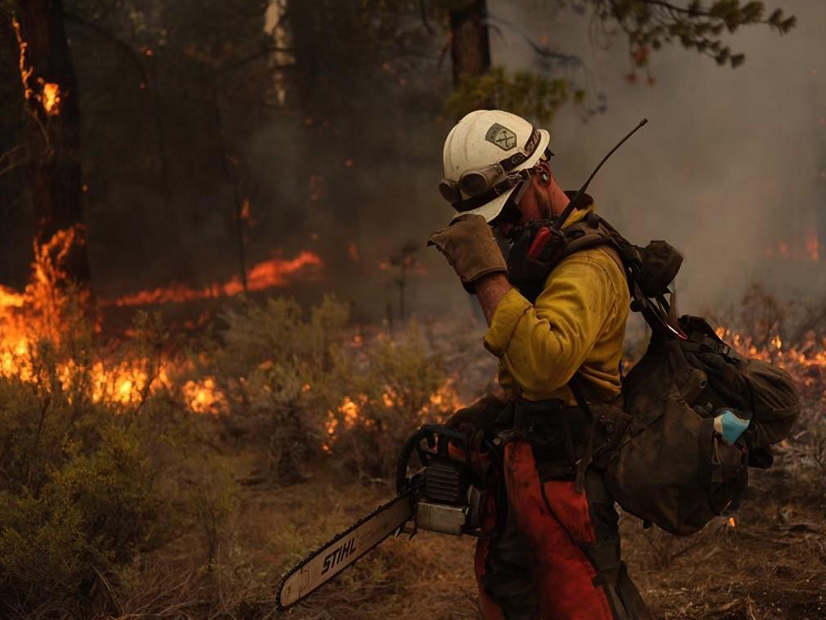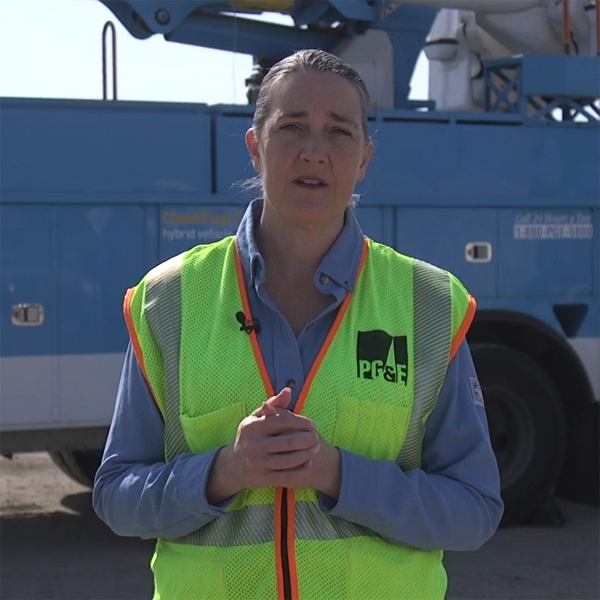
A prosecutor’s decision Friday to charge Pacific Gas and Electric (NYSE:PCG) with four counts of involuntary manslaughter from last year’s Zogg Fire came two weeks after the utility was sued for starting the immense Dixie Fire and grilled by a federal judge over why it didn’t do more to prevent it.
The filing of charges by Shasta County District Attorney Stephanie Bridgett marked the second time this year PG&E has been criminally charged for a wildfire and the fourth time in five years the utility has faced charges in disasters related to its gas and electric systems.
“While criminal prosecutions of corporations are rare, one of the primary reasons to charge a corporation criminally is a finding that illegal behavior is widespread. It’s serious. It’s offensive, and it’s so persuasive that the only appropriate action is criminal charges,” Bridgett said Friday in a press conference. “My office has made such findings and believes that criminal charges are appropriate at this time.”

“We’ve accepted Cal Fire’s [the California Department of Forestry and Fire Protection’s] determination, reached earlier this year, that a tree contacted our electric line and started the Zogg Fire … but we did not commit a crime,” Poppe said.
Cal Fire concluded in March that the Zogg Fire began on Sept. 27, 2020, when a leaning gray pine tree fell onto a PG&E power line near the rural community of Igo, in Shasta County. (See PG&E Equipment Started Zogg Fire, Investigation Finds.)
The fire killed an 8-year-old girl, the girl’s mother, a 79-year-old woman and a 52-year-old man who were overtaken by flames as they tried to flee. It burned more than 56,388 acres and destroyed 204 structures.
The DA’s office charged PG&E with involuntary manslaughter for the four deaths and accused it of 27 other felonies and misdemeanors related to the fire.
It was the second time the state’s largest utility has been charged with homicide. PG&E pleaded guilty in June 2020 to 84 counts of involuntary manslaughter and one count of arson in the 2018 Camp Fire. (See PG&E Pleads Guilty to 84 Homicides and Arson.)
Jurors convicted PG&E in August 2016 of six felonies stemming from the San Bruno gas pipeline explosion in 2010, which killed eight people. The crimes consisted of obstructing a federal investigation and violating pipeline safety standards; PG&E was not charged in the deaths. A federal judge sentenced the utility to five years’ probation starting in January 2017.
In April, Sonoma County prosecutors charged the utility with five felonies and 28 misdemeanors from the October 2019 Kincade Fire including “recklessly causing a fire with great bodily injury” to firefighters and emitting harmful contaminants such as wildfire smoke and ash into the air, harming children. PG&E has also denied criminal liability in the case. (See Prosecutors Charge PG&E for 2019 Kincade Fire.)
‘Reckless and Criminally Negligent’
Bridgett contended in her press conference that years of disasters have failed to improve PG&E’s safety culture.
“It appears they haven’t changed,” the prosecutor said Friday.

As in prior cases, she said, PG&E failed in its statutory and regulatory duty to maintain its equipment and clear vegetation to reduce the fire risk. The 100-foot-tall pine tree that started the Zogg Fire was marked as hazardous in 2018 but never removed; it had a damaged trunk and was leaning at a 23-degree angle on a downhill slope toward PG&E’s lines, she said.
“Their behavior was reckless and criminally negligent, and it resulted in the death of four people,” Bridgett said.
Poppe said Friday the utility has been struggling to cope with the West’s persistent drought and climate change that has “forever changed the relationship between trees and power lines.”
“Two trained arborists walked this line and, independent of one another, determined the tree in question could stay,” Poppe said in her statement. “We trimmed or removed over 5,000 trees on this very circuit alone.”
PG&E is investing $1.4 billion in vegetation maintenance and plans to remove 300,000 trees and trim 1 million more while burying 10,000 miles of power lines in high-threat fire areas, she said.
“This vital safety work is all done by real people who are trying every day to do the right thing,” she said. “My coworkers are working so hard to prevent fires and the catastrophic losses that come with them. They have dedicated their careers to it. Criminalizing their judgment is not right. Failing to prevent this fire is not a crime.”
Dixie Fire Proceedings
Federal Judge William Alsup, who oversees PG&E’s probation in the San Bruno explosion, has also said he believed it was “reckless, maybe criminally reckless, for PG&E to have left … that gray pine looming.” The judge has been trying to get PG&E to improve its line maintenance practices. (See CPUC, Judge Pressure PG&E to Clear High-Risk Lines.)
Alsup also has taken a hard line with PG&E on the Dixie Fire, a 963,000-acre blaze still burning in the Sierra Nevada Foothills of Northern California. It is the largest single blaze in state history and second only in the list of all-time-biggest fires to last year’s August Complex of 38 fires that grew together and topped 1 million acres.
Cal Fire is investigating the possibility that a fir tree falling on a PG&E line in the rugged Feather River canyon may have started the fire on July 13, and the utility has acknowledged its equipment may have sparked the blaze. (See PG&E Says Its Line May Have Started Dixie Fire.)
On Sept. 13, Alsup called a PG&E “troubleman” to the stand to answer questions about the day in mid-July when he was asked to investigate blown fuses on a PG&E line and hours later discovered a small fire that may have exploded into the Dixie Fire.
The troubleman, whose name was withheld from the media for his protection, described the hours it took him to reach the line over rough, circuitous roads, the Associated Press reported. When he finally got there, he found a fire burning near where a fir tree had fallen onto the line and tried to put it out using fire extinguishers and a shovel.
Alsup told the PG&E worker he did not blame him for the Dixie Fire but asked why PG&E hadn’t shut down the line once it was clear something was wrong, according to the AP. The troubleman said he would have needed an order from supervisors to shut off power to customers.
Alsup instructed PG&E to produce transcripts of calls between the troubleman, dispatchers and his superiors by Aug. 17. The transcripts filed with the court showed confusion among the parties and difficulty communicating by radio and cell phone over remote, mountainous terrain.
“If anyone can hear this, we have fire northwest of Cresta Dam on the hillside,” the troubleman said on a call after 5 p.m. When a supervisor eventually responded, the troubleman said: “There’s a fire on the hillside. It’s small now, but it’s picking up. … I would think if they get a helicopter up here, they can put it out quickly, if it gets here quick.”
Alsup told PG&E lawyers at the hearing that with only four months left in its probation, “my job is to rehabilitate you, and that is what I am going to do until the last minute,” the AP reported.
Two days later, the first lawsuits against PG&E were filed on behalf of 200 plaintiffs whose homes and properties were destroyed in the fire.
The San Diego law firm that filed the complaints, Singleton Schreiber McKenzie & Scott, said in a statement that the power outage in the Feather River canyon was first reported at 7 a.m. on July 13, but the PG&E troubleman did not arrive on scene until after 4 p.m. The law firm said PG&E was negligent in failing to maintain an appropriate clearance between its equipment and surrounding vegetation.
“It’s clear that PG&E started this fire,” lead attorney Gerald Singleton said in the statement. “The best thing they can do is to acknowledge that fact and make the survivors whole.”
Lawsuits over the 2015 Butte Fire, the 2017 Northern California wine country fires and the 2018 Camp Fire resulted in a settlement that gave a fire victims trust a 20% equity stake in PG&E at the conclusion of the utility’s Chapter 11 reorganization in June 2020.
Initially valued at $13.5 billion, the trust fund has lost at least $2.5 billion in value because of PG&E’s involvement in the fires of 2019, 2020 and 2021, the trustee said. (See PG&E Value Lags as Dixie Fire Rages.)

